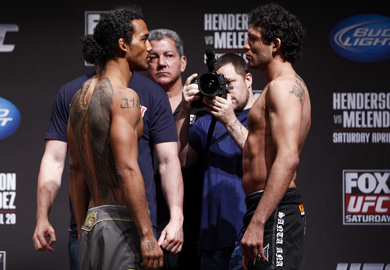With Recent CSAC Judging Mishap The NSAC Weighs In

This past weekend, UFC on FOX 7 went down and was headlined by a lightweight title fight between defending champion Benson Henderson and former Strikeforce champion, Gilbert Melendez.
The fight was a very close affair and most in my Twitter feed had it 50/50 with half giving close victories to the challenger and the other half giving it to a champion who narrowly escaped losing his title. The bout was officially scored a split-decision for Henderson with a score of 47-48, 48-47, 48-47.
It was almost impossible for this fight to be any closer and controversy was an absolute with fans from either side finding a reason to complain. These complaints were relatively just, however, as I stated earlier (and really can’t state enough), that this fight was decided by an extremely narrow margin.
Where the biggest controversy arose wasn’t over the fact that the fight was judged for the fighter who ultimately won, and retained his title, but instead over the identity of the judge who had scored it for Melendez. This judge was one Wade Vierra, a licensed referee under the California State Althletic Commission (CSAC) and a student under Cesar Gracie Jiu-Jitsu and instructor at a Cesar Gracie affiliated gym. Gracie is, of course, the same man who trains then lightweight challenger, Gilbert Melendez’ jiu-jitsu.
Now, although there would be an understandable bias for this man to pick Melendez, even if it were a subconscious one, this article is working to highlight the fact that whatever system that was used to select these judges, is perhaps flawed.
If judges are selected under CSAC policy at random, from a pool of potential candidates for high-profile fights, is there no screening process done once these random selections are made? Or, if these judges are hand selected, even from that same pool, by a member of the CSAC, where is the background check? This security measure wouldn’t necessarily be put in place to eliminate potentially corrupt judges and again, in no way am I calling Vierra corrupt, but instead, to avoid the potential of scrutiny upon such an occurrence that brings up obvious questions that for now, don’t have answers.
I tried to contact the CSAC today but was continually rerouted back and forth between two offices and never got ahold of anyone who had the authority to give an official statement on the selection of the judges that night or even an explanation on how the CSAC conducts its selections for high-profile fights such as this. Instead, I called a neighboring state whose athletic commission knows a thing or two about putting on UFC fights, the Nevada State Athletic Commission (NSAC).
Nevada truly is the home for combat sports as it has been a mainstay for both the UFC and major boxing events for years and is virtually synonymous with the fight game.
After a single phone call to the main offices of the NSAC, I was routed over to the direct line of the Executive Director for the NSAC, Keith Kizer. Although Kizer was understandably reluctant to discuss events that occurred outside of his own jurisdiction, he gave me some insight from the perspective of the governing body for combat sports in Nevada.
Kizer broke the process down to a few simple steps that take place when selecting both referees and judges:
For smaller events from lower level promotions, their can sometimes be as few as two referees and just 4-5 judges who oversee each fight with the numbers rising up to three or more referees with approximately seven judges.
As for the selection of officials (both referees and judges), in Nevada, Kizer stated that once a full fight card is official and arranged in the order that it will ultimately take place, officials are pulled from a pool based on what the company can spend and how big of a promotion the officials are coming in for. These officials are all put through the same test that grants them a license to officiate professional fights. Then, Kizer selects which officials will be overseeing which fights with a simple system that I assume would be similar to that of scheduling workers for a part-time job, giving everyone who is assigned to that card equal opportunity to both work and be rotated off for breaks in between assigned fights.
As for the judging of title fights, like the one in question, not only are the judges picked from that same pool, but anyone involved in the fight whether it be commissioners for the state, judges, or even the fighters involved in the fight, can call a meeting to come to an agreement on which judges are picked to oversee that fight in particular.
It is unclear if the CSAC follows a similar policy of letting even fighters have a say on certain judges, not to sway a scorecard in their favor, but instead to put the fight on as even a playing field as possible. Unfortunately for this bout, someone who potentially knew Melendez on a first-name, and friendly basis was selected as a referee in a fight that absolutely affects not only each fighters career, but also their life as a title fight in the UFC is the pinnacle of an MMA career in this contemporary world.
If this man was selected by hand, then shame on the athletic commission for failing to do their job in the way of avoiding controversy and potentially tilting the scale of equality.
If he was chosen at random and by some coincidence put in a fight that he may have had some stake in as an acquaintance of Melendez’ then shame on both the commission for their lack of a thorough look into the history of these judges backgrounds and also on Vierra who could have easily opted out of the assignment, not to get cut from a payday, but instead to get out of the spotlight and away from any negative allegations that could be thrown his way potentially marring his career as an MMA judge. Kizer even told me a story where a man that he knew as one of the all-time great judges in MMA turned down a judging position for a UFC fight that featured former light-heavyweight champion, Quinton ‘Rampage’ Jackson due to the fact that both were Tennessee natives and shared a friendly relationship, in a move that earned respect from Kizer for its honesty and humility. Again, Kizer felt it was smart not to comment directly on the situation in California for obvious reasons, but did say that a close personal relationship with a fighter is a definite red flag when it comes to being selected to judge or referee their fight.
As for the final score tally, Vierra had this close contest scored three rounds to two with Melendez winning rounds one, four, and five and agreeing with, or at least making up the majority of, the first three rounds, only getting singled-out for his fourth round scores. If this had been any other judge who shared nothing in the way of a personal relationship with Melendez, this score would be simply overlooked and honestly, it’s not a crime to overlook it still, but there was absolutely no reason for a slip-up like this to get past not only the athletic commission, but also the conscious of Vierra who will always carry a stigma with him to events, regardless of the validity of certain allegations.
The California State Athletic Commission should be more careful if they want to build up a reputation for putting on fair contests in a sport where judging and officiating as a whole is something that is nowhere near perfect.
Visit BJPENN.com for the latest MMA News and stay tuned for a follow up article written from the stand point of the California State Athletic Commission, hopefully within the next day or so.
This article appeared first on BJPENN.COM
Previous Post
Topics:
UFC NEWS








